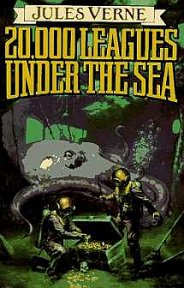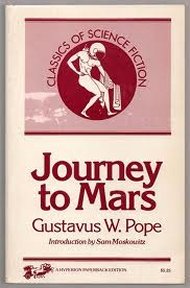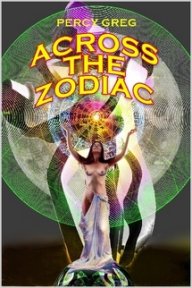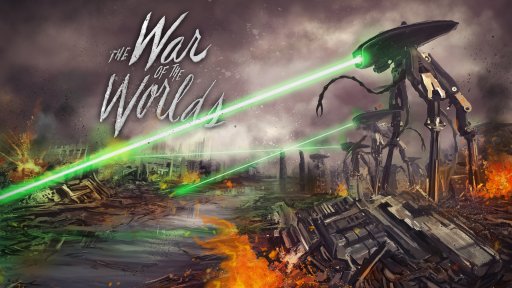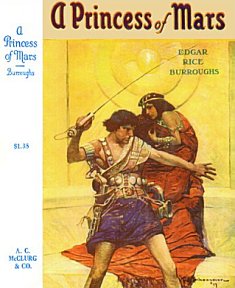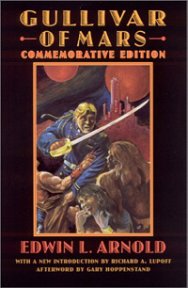
Official Edgar Rice Burroughs Tribute and Weekly Webzine Site
Since 1996 ~ Over 15,000 Web Pages in Archive
Presents
Volume 5019
Antarctica and Mars in Early Genre Fiction
By Jeff Deischer
Copyright 2009 by Jeff Deischer: ikonoklast61@juno.com
Part II: Mars
(Continued from Part I: Antarctica)There is one final facet of Antarctica we must examine, one that takes us to ... Mars. And we begin with another Verne novel: in Twenty Thousand Leagues Under the Sea (1869), Captain Nemo takes the Nautilus south, in hopes of reaching the south pole. When he does so (near the vernal equinox), he finds a sea there, beyond the outer ice pack (CH 11-14 of Part 2). There he finds a rocky island full of birds and lichen. This same circumstance is found by Lt. Frederick Hamilton in Gustavus Pope’s Journey to Mars (1894).Hamilton is a United States Navy lieutenant on furlough in order to take part in an Antarctic expedition that leaves Melbourne, Australia on November 10, 1891 (CH 1). Upon reaching “land” – an ice shelf – Hamilton is one of a small party that crosses over a ridge to find an inland sea, and a couple of days later, returns there to plant the American flag, claiming the sea for that nation (CH 3). His group of three is then trapped by ice in their long boat (CH 3), and, after one of them dies, Hamilton and his companion John are inadvertently rescued by Martians (CH 4). After saving the Martian Prince Altfoura from an attack by sharks (CH 4), Hamilton is invited to Mars, and, after lengthy preparations, he and John are taken there by a vehicle that rides “Cosmo-magnetic” currents, thereby allowing them to travel faster than the speed of light (CH 10-17). Pope’s Martians are highly advanced. He explains that each outer planet is older than its inner neighbor, and their races are correspondingly old (CH 11); therefore the Martians are older than Earth beings (CH 36) while Venus has not yet developed humanoid life – it is still a primitive jungle world (CH 12). Mars is home to eight billion people (CH 25); they live in “linear cities” that line some of their world’s canals (CH 24). Their culture is 22,000 years old (CH 36).
Mars – Arios Vizulojan in the native tongue – is inhabited by three native races (CH 4), the yellow Arungas, the blue Nilatas and the red Rohitas. Within each of these general skin tones are varying hues, from dark to light. Each race has their own physical specialty: the Rohitas are strong, the Nilatas are robust, while the Arungas – the last to evolve but the first to possess culture or civilization – are graceful (CH 36). They are otherwise identical, apparently; they are, for example, all humanoid in shape.
A number of Plutonians also live on Mars, and most interbred with the native population thousands of years ago, causing a degeneration of the Martian race, particularly in the southern hemisphere (CH 33). This doesn’t quite make sense according to Pope’s own theory, for if they are older, they should be more advanced, not less; they at least possessed interplanetary space flight six thousand years ago (CH 31). It seems this degradation came from the mixing of the two races.
“Pluto”, in this case, was the planet next to Mars that was destroyed (CH 18) six thousand years ago, creating the asteroid field (CH 22, 31) (the planetoid we know as Pluto was not discovered until 1930, so Pope anticipated the use of the name; perhaps our planetoid is a remnant of the once-great planet. One must wonder if Pope chose the name Pluto because it is that of the god of death, and the planet “died” in an explosion); as Martian culture is older than human, so was Plutonian culture older than Martian. Plutonians are giants, standing ten feet tall (CH 22), with at least some possessing “red gold” (CH 22) or “bronze” (CH 38) skin.
Pope’s Mars is the Mars of the Victorian age: It possesses the “continents” and “seas” observed by Earth astronomers using primitive telescopes late in the nineteenth century (CH 20). He dutifully tells us what Earth identification matches which location on Mars (e.g., the kingdom of Mandal-Uttima is on “Galileo’s continent” (1)).
Hamilton’s narrative ends on December 27, 1892, with a note prefacing his manuscript (or notes for one; he would seem not to have had the time to write a full manuscript), explaining that a meteor shower is due to hit Mars within less than sixty days, wiping out Martian civilization. Now, before embarking on a rescue mission to evacuate some millions of Martians to Earth, he wants a record of his activities to go to an old friend of his father (CH 62), a doctor who was apparently Pope himself (Introduction). And that is how the novel ends.
What happened to Pope’s Martians? Perhaps the proposed evacuation of Mars never took place. Certainly, no large number of Martians were living in Antarctica when Dyer’s expedition went there in At the Mountain of Madness, the only later-occurring account of Antarctica. Perhaps the Martians retreated underground for the winter, and found the ancient city of the Old Ones. Perhaps, they, too, awakened one or more of the Old Ones or their slaves, the Shoggoth, as “poor Lake” had done. Or maybe they returned to Mars to re-build after the meteor shower impact. This last seems the most likely to me.
But there may be evidence of the Martians’ presence in Antarctica: apparently the south polar sea froze over completely between 1892 and 1930. We should not immediately think that the Martians contrived this change, for their own world was not frozen; certainly, they would not have preferred such a climate. If this change came about due to their presence, it was possibly accidental, therefore, and may have involved the Old Ones. But they surely did not welcome the cold, either. Is it possible then that the Martians did cause the climate of the south pole to change – upon discovering the Old Ones there? Mightn’t they have created a frozen prison for the surviving Old Ones – who may have already been in hibernation as the ones Lake found were – in order that the powerful and deadly beings never become a threat to humanity? It at least seems possible, and we have no other theory to explain the sudden climate change.
However, the change might not be as sudden as it seems. In 1840, the south pole is clear of ice; in fact, there is a channel cutting through the entire Antarctic Circle, so that passage is possible from one side to the other, though the narrower of the two openings is frozen over for half the year. Joerling thinks that the entire channel freezes over completely in the winter, though this is disputed by evidence in A Strange Discovery, which states that the south pole crater keeps the polar region warm all year round. Certainly the western region is colder than the eastern, where the Hili-li live, which no doubt contributed to Joerling’s conclusion. When Nemo goes to the south pole (“1868” (2)), it is completely surrounded by ice, and the Nautilus must submerge and travel under the water to the pole, where it surfaces in a sea. This is the situation in 1891. By 1930, the south pole has completely frozen over, leaving no trace of the sea. All this in a century’s time. Given the temperatures stated in all accounts, this is surely not a natural process, and would therefore seem to be connected to the Old Ones in some way. However, the big change only really occurs after the arrival of the Martians in 1892 (the pole is in fact completely frozen over in 1894, if we are to believe The Clipper of the Clouds). The change in the ice ring between 1840 and 1891 is not so great, apparently. It is not entirely clear from Hamilton’s account that the sea does not extend out beyond the pole, and it is possible that it was a particularly cold summer when Nemo arrived, explaining the extra ice. This brings us back to the possibility that the Martians were somehow behind the climate shift.
While it might seem impossible that the Martians could effect such a change in climate, recall that they possessed faster-than-light travel, so it doesn’t seem even unlikely that they could possibly control the weather, at least in a limited way.
The second question raised by the possibility of Pope’s Martians at the south pole is, what happened to the Hili-lites? It is possible that Hamilton and the Martians never saw the Hili-lites in the short time prior to the journey to Mars, particularly if they were on the west side of the area, as the crew of the Halbrane was; the Hili-li never ventured across the central crater territory. But if a large number came to Earth as Hamilton suggests, the two populations would surely have made contact at some point. The two peaceful cultures must surely have gotten along; if not, the Hili-lites wouldn’t have stood a chance. If the Old Ones were discovered, then perhaps the Hili-lites evacuated to Mars along with their Martian guests, in order to escape the coming deep freeze planned by the Martians. Or perhaps the Martians were not in Antarctica long enough to meet the Hili-lites, who must have been killed when the pole froze over.
I must admit I have ambivalent feelings about including Pope’s Mars into a “shared fictional universe” (SFU): it is far too “fanciful”, in my opinion, and by that I mean too fantastic. Even if we accept that Mars is inhabitable and inhabited – which alone is fairly incredible for a realistic fictional universe – he uses many primitive theories that have since been disproven (as does Verne, it must be admitted). For example, the asteroid belt is believed never to have been a planet; and no disturbance such as a planet exploding occurred in our solar system six thousand years ago.
This number figures in another of Pope’s history of the solar system: He says that Earthmen are 6000 years old and Martians 22,000 years old. Now, if he is referring to culture, then we can use these figures; Earth civilization is roughly 6000 years old. But Pope seems to be referring to the Christian “theory” that the Earth was created in 4004 BC, based on counting the passages of time listed in the Old Testament. In 1892, the Earth is therefore nearly 6000 years old. Mars, being older in Pope’s theory of planetary formation, is 22,000 years old. 1892, in the Martian calendar, is the year 21992 – which actually makes the Mars race nearly 40,000 years old, since Martian years are nearly twice the length of Earth years ... which Pope knows, as he reminds us more than once when referring to the seasons.
If we take Pope’s figures as referring to civilization, then we can accept them. But if we take them as he meant them – referring to physical development, then they would seem to be missing a zero: Cro Magnon, the direct ancestor of Homo Sapiens, appeared roughly 60,000 years ago. We should then add a zero to the Martian race figure, as well, meaning they evolved 220,000 Martian years ago, attaining civilization – and their calendar – roughly 22,000 Martian years ago, circa 39,000 BCE. This would explain their technology, which is centuries if not millennia ahead of Earth’s. his Earth south pole is identical to Verne’s in Twenty Thousand Leagues Under the Sea -- and thus to other depictions of Antarctica in nineteenth century fiction -- and perhaps that is not enough. Considering Journey to Mars’ narrative style, plot and genre, I think it highly likely that Pope had read the Verne book – as the father of science fiction, Verne pioneered the first-person narrated travelogue novel (though the first “sword and planet” novel was Percy Greg’s 1880 Across the Zodiac, which described an 1830 trip to Mars, and though Poe himself used this format, it seems to have been Verne who adopted it for regular use and made it popular) -- and may have taken his description of the south pole directly from Twenty Thousand Leagues Under the Sea.
Before we accept Pope’s version of Mars in our SFU, how does it fit with other popular contemporary depictions of Mars? The two most famous versions probably come from H.G. Wells’The War of the Worlds (1898) and Edgar Rice Burroughs’ John Carter series (beginning in 1912, with “Under the Moons of Mars” (later published as the novel A Princess of Mars)).
In the case of the former, it may be significant that the lights seen by Earthmen are seen at Mars – not on Mars (CH 1). And it is this observation that makes the narrator – and later, everyone else – believe that the aliens come from Mars. But the gaseous jets observed could just as easily be large spaceship engines firing from Mars’ orbit. And if we are to accept a Mars populated by humanoids as Pope describes, then they must be. .
In the second case, John Carter’s Barsoom is a dying world. Its oceans have long since dried up and what water remains is circulated about the planet by the vast canal system observed by several Earth astronomers during the thirty-five years preceding the publication of the story (particularly Schiaparelli, whose use of the Italian word canali, meaning “channels”, gave rise to the belief that these channels were man-made, i.e, canals). Burroughs drew heavily on what was “known” about Mars (particularly Percival Lowell’s book on the planet) when constructing Barsoom: canals meant water that was scarce and “men” there to build them. We cannot reconcile this with Pope’s thriving Mars. And perhaps we do not need to.
In his book, A Guide to Barsoom (1976), John Flint Roy discusses Barsoom as Mars (CH 10). He notes that no one in any of ERB’s stories ever reached Barsoom by travelling through space. John Carter and Ulysses Paxton did so by some form of astral travel, or teleportation. Roy claims, rather persuasively, that Barsoom is in another dimension. One cannot fly between Barsoom and Earth, or between Earth and Sasoom (Barsoom’s Jupiter). Space travel between Barsoom and Sasoom, for example, in “Skeleton Men of Jupiter” (1943), occurred only within that dimension.
So Barsoom and Mars – whether or not we accept Pope’s version of the red planet – are not one and the same. .
.
The Mars that Gullivar Jones finds in Edwin L. Arnold’s Lt. Gullivar Jones (1905) is closer to the later-published Barsoom than the high tech world of Journey to Mars. Like Pope’s Hamilton, Gullivar is a United States Navy lieutenant. He is taken to Mars, however, by a magic carpet. There, he falls instantly in love with a Martian princess, and when she’s kidnapped (more or less), he spends the remainder of the novel rescuing her. He then returns home, via the same rug. But his Martians, the Hither Folk, are even more primitive, technologically, than Carter’s red men; they appear not even to have developed glass.
All three planets share in common a number of races with red, yellow and other skin tones; psi ability; a universal language for Mars; the widespread use of hand weapons (Arnold’s Thither Folk use maces, but Gullivar seemingly has the only sword on the planet, his navy cutlass). In all three, the red race is physically powerful compared to the yellow race, who are more civilized. But, despite these similarities, the three worlds cannot readily be reconciled with one another. Because of the technology level of the yellow Hither Folk in Arnold’s novel, the events of it cannot occur concurrently with Pope’s as it would seem to do based on publication dates. And because Arnold’s Mars, too, is a thriving world with abundant natural resources including oceans, it cannot be Barsoom ... at least Barsoom in John Carter’s time.
Gullivar believes he went to “Mars” because that is where he wished to go just before being taken to the alien world (CH 1). While this planet is identified as being the fourth from its sun by An, a “Martian” (CH 2), its solar system’s third planet is never specifically identified as Earth (of which the “Martians” know; this does not indicate that this is in fact Mars, only that there is two-way transportation between the two worlds, which one Martian confirms by telling Gullivar that he is not the first alien she has seen (CH 9); a woodman claims he knows of an alien from an ethereal world, as well (CH 13)).
What if the magic carpet that took Gullivar to “Mars” was programmed to return home, and did not literally respond to his wish to go to Mars?
I believe Gullivar was transported to another planet in another planetary system (or dimension) that he believed was Mars, based on very little hard evidence. Since this is also the case with John Carter, could Gullivar’s Mars be Carter’s Barsoom?
While there are similarities, there are differences, as well: Gullivar’s Mars has a great ocean, and is heavily forested (at least west of Seth, the capital of the Hither Folk). Carter’s Martians, with fliers and atmosphere factories, are much more technologically advanced than the Hither People, who are a Bronze or Iron Age civilization. So it would seem not to be the case that these two worlds are one and the same. But I wonder if Jones did not, in fact, travel into Barsoom’s past.
When Gullivar travels to “Mars”, he admits he became confused: “time and space and circumstances all lost their meaning to me.” He later only assumes that he travelled overnight from Earth to Mars. So it seems possible that he travelled in time as well as space. It was a magic carpet, after all, that transported Gullivar.
How does Gullivar’s Mars fit what we know of Barsoom? Half a million years before the time of John Carter (which we presume to be the present), Barsoom was home to mighty civilizations that sailed the seas. Certainly, this could describe Gullivar’s Mars, after the conquest of the yellow Hither Folk by the red Thither People, who live on a neighboring continent. Is it a coincidence that on Barsoom that the Yellow Race has nearly been wiped out, long thought to have been extinct?
Then the oceans began to dry up. Could the near collision with the giant asteroid (Lt. Gullivar Jones, CH 16-18) have shifted Barsoom’s orbit and begun that planet’s slow death?
While Gullivar is in the capital of the Thither, some sort of celestial body passes through the atmosphere to the west. It is large enough (and “slow” enough) to remain visible for three days, and its influence was felt a day earlier. It makes the region hot enough to evaporate standing water (although, oddly, no one is burnt by the heat). Considering that the object is visible for three days, it would seem to have been some distance away from Mars, but also extremely hot to affect the surface of the planet. It would therefore also had to have been very large, for, even being distant from the surface, it is described as a “red eye”, not a shooting star. Given these facts, it would seem to have passed very near Mars, in astronomical distances.
While not conclusive, it seems quite possible to me that Gullivar’s “copper” skinned Thither Folk later became John Carter’s red men of Barsoom, hundreds of thousands of years after Lt. Gullivar Jones. This would also explain the vast difference in technology between the two cultures.
Based on the seasons on both Mars and Earth described in the novel, Gullivar would seem to have gone to “Mars” in March, 1893 – just a year after Hamilton went to his Mars. Because of the similarities between the two stories – particularly that the lead character in each is a USN lieutenant – I have to wonder if Pope had heard of Gullivar’s manuscript, and wrote his own version, an entirely fictional one (unlike Hamilton, Gullivar had time to write a full manuscript). This would account for the similarities, as well as the impossible science seen in Pope’s novel – an inhabited Mars that has, among other things, faster than light travel. But we are not quite finished.
Lastly, we must consider the Michael Kane trilogy (1965), Michael Moorcock’s homage to or pastiche of ERB’s Barsoom. Moorcock, with fifty years’ hindsight, placed his series in Mars’ distant past, when it was believed that the planet had standing bodies of water, and therefore possibly life. Kane, however, had little more than Gullivar Jones did to discern his destination: “The size of the sun and the fact that the gravity was less here than on Earth seemed to indicate Mars”, he observes. Shizala, the Martian princess, adds, this “is the fourth [planet] from the sun”, and “there are no men on Negalu, the third planet. Only steaming jungles and monstrous beasts!” (Warriors of Mars, CH 2). Kane concludes that he has been thrown back in time millions of years, back to the age of dinosaurs.
While these facts are not conclusive, they are very suggestive. How likely is it that the configuration of this solar system would be identical to our own?
Conscious of the physical characteristics of Vashu – the Martians’ name for Mars – we would expect Kane to notice any irregularity in the sky regarding planetary bodies (i.e., the constellations), so let us agree that Kane was transported (or transmitted, rather) to Mars, a hundred million years or so in the past. The same could presumably be said of either John Carter or Gullivar Jones – however, neither of them were scientists, and it’s quite possible that neither would notice anything amiss in the night sky of Barsoom. How many people would, even in this day and age?
Barsoom’s planetary system at least superficially resembles that of Earth; we do not know the state of that solar system beyond a few of its worlds: inner planets Cosoom (Venus) and Jasoom (Earth), and the outer giant Sasoom (Jupiter). No trip was ever made to Jasoom from Barsoom, so the state of affairs there is unknown. One such journey could be quite telling.
Roy implies that Barsoom lies in a parallel dimension, one that is very similar and very different from ours; therefore, its solar system would be identical in configuration to ours, despite the differences in each planet. Gullivar, a sailor, would probably in fact be acquainted with the night sky, and if Roy is right, then there would be nothing amiss to see. This is probably a moot point, as Gullivar never mentions actually looking up into the night “Martian” sky.
Now let us once again consider Pope’s Mars. His Martians, as a race, are no older than 390,000 years old, while Kane goes back in time millions of years. So it would seem that these two Martian races cannot be one and the same; and with an apparent gap of millions of years between them, Kane’s Martians cannot be the ancestors of Pope’s.
Is it possible that Pope’s Martians travelled through time as well as space without knowing it, just as Kane did? This would account for their ability to seemingly travel faster than the speed of light. Perhaps they existed on Mars before the time of Kane’s journeys there, and the destruction of their civilization resulted in a more primitive society that arose following the impending catastrophe described at the end of Journey to Mars. This would explain the giant blue-skinned Argzoon, who resemble Pope’s Plutonians – at least one of whom is blue-skinned; the Argzoon could be giant hybrids between Plutonians and blue-skinned Martians, explaining their “degenerate” or barbaric ways -- and Pope’s Martians could be Kane’s Sheev and Yaksha, “older” and more advanced races of Vashu who are related and of whom there are few left by the time of Kane’s arrival. If this is the case, then the events of Journey to Mars precede those of the Michael Kane trilogy by “millennia” (Blades of Mars, CH 1). This also addresses the concern of a thriving population on Mars as late as 1892: in Earth’s present, Mars is indeed a dry, dead world. And this also places the destruction of Pope’s “Pluto” a hundred million years in the past, not “six thousand” years ago.
Based on information in the Michael Kane trilogy, the impending conflict at the end of Journey to Mars seems to turn into a full-scale war following the bombardment of Mars by asteroids that wipe out its civilization. What is left of that is destroyed by the “Mightiest War” between the good Sheev and the evil Yaksha (Blades of Mars, CH 1). “Millennia” later, a new civilization arises, one that superficially resembles the one on John Carter’s Barsoom. Kane’s Martians, being “white”, would seem to be evolved from the survivors of Pope’s red-skinned Rohitas: "(considering what we now know about Mars, it seems likely that the Rohitas interbred with the Hi-lili to produce this "white" race")." Unlike the Barsoomians, they have little understanding of technology, and use what was left behind by the Sheev.
Further, Vashu also has a yellow race, and at least the white race of Martians are susceptible to the germ warfare of the Sheev or Yaksha, strongly suggesting that they themselves are descended from those ancient races. Kane’s Vashu and Pope’s Arios Vizulojan fit together surprisingly well (3).
So:
In 1828, the crew of Jane Guy discovers a native black-skinned race in the Antarctic. Pym and Peters continue on, discovering the Antarctic continent, which is a mountainous ring surrounded by a number of islands.In 1839, the Halbrane, captained by the brother of the captain of the Jane Guy, goes in search of the missing Jane Guy and her crew, finding them in Antarctica. The survivors of the Halbrane are the first men to find the south pole, which seems to lie in a wide channel that transverses the Antarctic Circle. Pym’s corpse is discovered at a gigantic lodestone near the apparent magnetic south pole.
In 1866, John Carter goes to Barsoom for the first time. This is apparently their “present”, though “present” and “past” tend to lose their meaning when dimension- and time-travelling; Carter would seem to only travel between dimensions, and not through time, as well, with his astral travel. For example, the same amount of time passes on Barsoom as it does Earth in the Carter series, which would not necessarily be the case if he were time-travelling, as well.
In “1868”, Captain Nemo makes the first submarine journey to discover the south pole, at which lies an inland sea.
In 1892, Frederick Hamilton goes to Mars (leaving from Earth’s south pole), arriving roughly one hundred million years in the past, due to the “ethervolt” vehicle’s mode of transportation.
In 1893, Gullivar Jones goes to Barsoom on a magic carpet, arriving some half a million years before John Carter’s first visit.
In 1930, an expedition led by Dyer goes to Antarctica and discovers a vast mountain range the equal of the Himalayas. The south polar region is now completely frozen over. One of the team members, Lake, finds the hibernating Old Ones, one of which awakes and kills all of the expedition members except for Dyer and his companion, who is driven insane by what he sees.
In 1964, Michael Kane is sent by his matter transmitter to Mars’ past, some thousands of years after Hamilton’s journey, roughly one hundred million years ago.
(1) I cannot find any contemporary map of Mars that used “Galileo’s continent” (or one named after Newton). However, Pope must be using Proctor’s 1867 map (which was based on the 1862 drawings by Dawes – who put his own name no less than six times on his map of Mars!) because of his use of “Madler’s continent” – normally just Madler Continent on period maps; Proctor originated the use of astronomers’ names for Martian features (previously it had been letters of the alphabet and later Schiaparelli proposed using Greek names, which became the accepted form for subsequent namers. He gave us Chryse, Hellas, et al. Areas on Proctor’s map are named after observers of Mars – Kepler and Copernicus being the two most recognizable names today, for example, both of which Pope mentions. Pope also seems to have moved the meridian normally used on this map to 180o, because he places Madler “east”, when it fact it is west of zero longitude on the traditional maps of Mars. I did investigate the possibility that Pope was unaware of the fact that this map is traditionally drawn upside down, with south at the top – but his description of two great oceans – one of which he identifies with the Kaiser Sea – suggests that he was viewing the map correctly, and changed the traditional longitude (Mars’ “Greenwich”) for some unexplained reason.(2) The date is in quotation marks because the two accounts of Nemo’s life, in Twenty Thousand Leagues Under the Sea and The Mysterious Island, give conflicting dates for the events of the former story. “1868” comes from the former story.
(3) If this is true, then it is Kane who has his directions mixed up: On Vashu, the Western Ocean is in the northern hemisphere – the opposite of the traditional layout of Mars in the late nineteenth century; and the Blue Giants live in the north – the opposite of Pope’s. We should not take this as either an error on Kane’s part, nor as evidence that the two Marses are not one and the same: Kane is using directions that the Martians themselves use, and there is no reason that their choice of north and south would match the one Earth observers have given the planet.
Varnal would seem to be located on Secchi or Madler, since the Argzoon and Mendishar live on the same continent in the “northern” hemisphere, and, across the Western Ocean – Mars’ only true one -- lies the “Western Continent” of Lockyer and/or Cassini (it is really one landmass with a large bay separating the two regions). This corresponds to Pope’s Sundora-Luzion, which began the war in Journey to Mars, and was allied with the giant Plutonians, you may recall. Vashu’s Mightiest War was fought there, which also fits with events on Pope’s Mars.
THE END
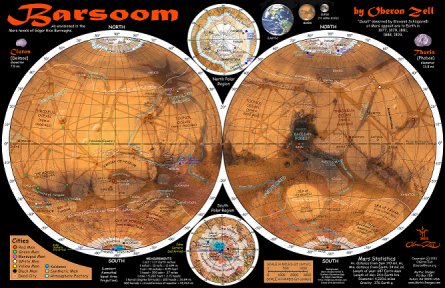
JEFF DEISCHER
ikonoklast61@juno.comJeff Deischer is a Marvel Comics Silver Age and Doc Savage scholar who has a passion for chronology. Among his non-fiction works are The Way They Were: the Histories of Some of Adventure Fiction's Most Famous Heroes and Villains (which contains the above essay), The Marvel Timeline Project, Part 1 and The Adventures of the Man of Bronze: a Definitive Chronology.He has also written a number of novels, including the pulp superhero series THE GOLDEN AGE, of which five volumes have been published thus far.
Suggested reading
The Sphinx of the Ice Fields ~ Jules Verne
The Narrative of Arthur Gordon Pym of Nantucket. ~ Edgar Allan Poe
A Strange Discovery ~ Charles Romyn Dake
Twenty Thousand Leagues Under the Sea ~ Jules Verne
Mysterious Island ~ Jules Verne
At the Mountains of Madness ~ H.P. Lovecraft
“Who Goes There?” ~ John W. Campbell
The War of the Worlds ~ H. G. Wells
A Princess of Mars ~ Edgar Rice Burroughs
Across the Zodiac ~ Percy Greg
Lt. Gullivar Jones ~ Edwin L. Arnold
Journey to Mars ~ Gustavus W. Pope
Across the Zodiac ~ Percy GregAPOCRYPHAL BARSOOMS I
It's ALL The Same Mars by Den Valdron
Mars Guide ~ ERBzine
ERBzine Barsoom Atlas


BILL HILLMAN
Visit our thousands of other sites at:
BILL AND SUE-ON HILLMAN ECLECTIC STUDIO
All ERB Images© and Tarzan® are Copyright ERB, Inc.- All Rights Reserved.
All Original Work © 1996-2015/2019 by Bill Hillman and/or Contributing Authors/Owners
No part of this web site may be reproduced without permission from the respective owners.
